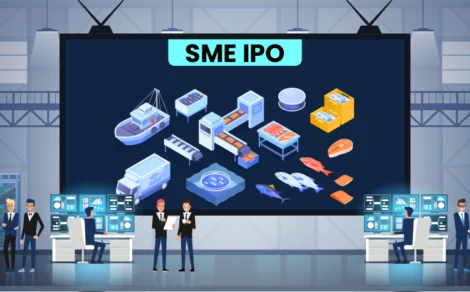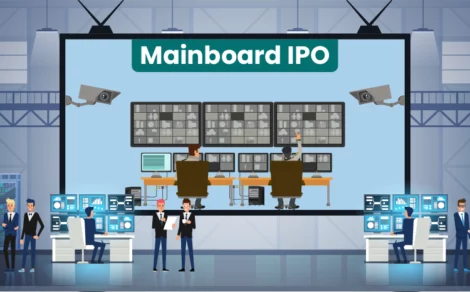Ever heard about Sensex and Nifty 50? These are the two most important stock market indices of the Indian stock market. Investors follow these indices to check the overall market condition and make investment decisions.
Sensex, or Stock Exchange Sensitive Index, contains the 30 largest shares of BSE, and Nifty, or National Stock Exchange Fifty, includes the top 50 shares of NSE. Both of them provide a broader representation of the market mood. If you are an investor in the Indian stock market, you would have likely heard these names several times.
If you don’t understand what Sensex and Nifty 50 are, don’t worry, as you are in the correct place. In this blog, you will get detailed information about the difference between Sensex and Nifty and how they are calculated. Let’s get started.
What is Sensex?
Sensex is the stock market index that contains the top 30 shares of the Bombay Stock Exchange in terms of market capitalisation. On January 1, 1986, Sensex was introduced. with an initial value of just 100. As of January 2025, Sensex is trading at a value of 77378.91 while its all-time high value is 85,978.25.
The S&P BSE Index Committee decides which stock will be eligible to stay in this top list. Here are some conditions for companies to get included in Sensex:
- Companies must be registered on the Bombay Stock Exchange in India.
- They should primarily include large or mega-cap stocks.
- These stocks need to have sufficient liquidity.
- Companies are required to earn revenue from their core operations.
- They must also play a role in maintaining balance within the country’s equity market sector.
List of Stocks in Sensex:
Here is a list of shares in the Sensex index as of January 2025:
| Company Name | Sector |
| TCS | IT Services & Consulting |
| Tech Mahindra | |
| HCL Technologies | |
| Infosys | |
| Bajaj Finserv | Finance (Investment) |
| Bharti Airtel | Telecommunications |
| Hindustan Unilever | FMCG |
| Larsen & Toubro | Engineering & Construction |
| Bajaj Finance | Finance (NBFC) |
| Nestle India | FMCG |
| HDFC Bank | Banking – Private |
| Tata Motors | Automobile |
| Zomato | E-commerce |
| Maruti Suzuki | Automobile |
| Reliance Industries | Conglomerate |
| ICICI Bank | Banking – Private |
| Mahindra & Mahindra | Automobile |
| ITC | Cigarettes & FMCG |
| Asian Paints | Chemicals & Fertilizers |
| Titan | Diamond & Jewellery |
| Kotak Mahindra Bank | Banking – Private |
| Adani Ports | Ports & Port Services |
| Power Grid | Power Generation/Distribution |
| Tata Steel | Steel |
| Axis Bank | Banking – Private |
| Sun Pharma | Pharmaceuticals |
| State Bank of India | Banking – Public |
| UltraTech Cement | Cement |
| NTPC | Power Generation/Distribution |
| IndusInd Bank | Banking – Private |
What is Nifty?
Nifty 50 is the primary stock market index of the National Stock Exchange that contains the top 50 companies. On April 22, 1996, Nifty was launched with a value of 1000. Now, the value of Nifty is 23,431.50, and the all-time high mark is 26,277.35.
Here are the eligibility criteria to become eligible for Nifty 50:
- The company must be listed on the National Stock Exchange (NSE) and traded in the Futures & Options segment.
- Stocks must exhibit high liquidity, with an average impact cost of 0.50% or less over six months for 90% of observations.
- Selection is based on free-float market capitalisation, calculated using stock price and available shares.
- A company must maintain a trading frequency of at least 100% over the past six months.
List of Stocks in Nifty:
As of January 2025, here is a list of companies under Nifty 50:
| Company Name | Sector |
| HDFC Bank Ltd. | BFSI |
| ICICI Bank Ltd. | |
| Reliance Industries Ltd. | Oil & Gas |
| Infosys Limited | IT & ITES |
| ITC Limited | FMCG |
| Larsen and Toubro Ltd. | Construction & Infrastructure |
| Bharti Airtel Ltd. | Telecom |
| Tata Consultancy Services Ltd. | IT & ITES |
| Axis Bank Ltd. | BFSI |
| State Bank of India | |
| Mahindra & Mahindra Ltd. | Automobiles |
| Kotak Mahindra Bank Limited | BFSI |
| Hindustan Unilever Ltd. | FMCG |
| HCL Technologies Ltd. | IT & ITES |
| Sun Pharmaceutical Industries Ltd. | Healthcare |
| Bajaj Finance Ltd. | BFSI |
| NTPC Limited | Power |
| Tata Motors Ltd. | Automobiles |
| Trent Ltd. | Retail |
| Power Grid Corporation of India Ltd. | Power |
| Maruti Suzuki India Limited | Automobiles |
| Titan Company Ltd. | Consumer Durables |
| UltraTech Cement Limited | Construction & Infrastructure |
| Tata Steel Ltd. | Metals & Mining |
| Asian Paints Limited | Chemicals & Fertilizers |
| Bharat Electronics Ltd. | Capital Goods & Industrial Consumables |
| Tech Mahindra Ltd. | IT & ITES |
| Bajaj Auto Limited | Automobiles |
| Oil & Natural Gas Corporation Ltd. | Oil & Gas |
| Grasim Industries Ltd. | Diversified |
| Hindalco Industries Ltd. | Metals & Mining |
| Coal India Ltd. | |
| JSW Steel Ltd. | |
| Adani Ports & Special Economic Zone | Transportation & Logistics |
| Bajaj Finserv Ltd. | BFSI |
| Cipla Ltd. | Healthcare |
| Shriram Finance Ltd. | BFSI |
| Wipro Ltd. | IT & ITES |
| Nestle India Ltd. | FMCG |
| Dr Reddy’s Laboratories Ltd. | Healthcare |
| HDFC Life Insurance Company Limited | BFSI |
| Apollo Hospitals Enterprise Ltd. | Healthcare |
| Eicher Motors Ltd. | Automobiles |
| IndusInd Bank Ltd. | BFSI |
| SBI Life Insurance Company Ltd. | |
| HDFC Bank Ltd. | |
| ICICI Bank Ltd. | |
| Reliance Industries Ltd. | Oil & Gas |
| Infosys Limited | IT & ITES |
| ITC Limited | FMCG |
Difference Between Sensex and Nifty
So, what are the differences between Sensex and Nifty? Follow this table to get a side-by-side comparison:
| Parameter | Sensex | Nifty |
| Full Name | The full name of Sensex is S&P BSE Sensex | The full name of Nifty is NSE Nifty 50 |
| Base Value | The value was 100 when incorporated. | It started with a base value of 1000 points |
| Exchange | Sensex is set at the Bombay Stock Exchange (BSE) | Nifty is present at the National Stock Exchange (NSE) |
| Ownership | The Sensex index is managed and owned by BSE Ltd | Nifty and S&P CNX Fifty manage and own the Nifty 50 index |
| Base Year | The base year of Sensex is 1978-79 | The base year of Sensex is 1995 |
| Composition | It contains India’s top 30 companies | It contains India’s top 50 companies |
| Base capital | N/A | The base capital was ₹2.06 trillion |
| Sector Exposure | It contains 13 major sectors | It has shares across 24 sectors |
| Examples of ETFs/ Index Funds | Sensex ETFs, Sensex Mutual Funds | NIFTY 50 ETFs, Nifty 50 Mutual Funds |
How to Calculate the Sensex Index?
Here is the process of how to calculate Sensex:
From September 1, 2003, Sensex has been calculated using the free-float market capitalisation method. This method considers only the shares that are readily tradable in the market. It excludes the shares of promoters and locked-in shares.
Calculation Process:
- First, calculate the market capitalisation of each company by multiplying the total number of shares issued by the current stock price.
- Determine the free-float factor for each stock, which reflects the proportion of shares available for trading. This factor is then applied to the market capitalisation to derive the free-float market capitalisation.
Formula:
Sensex = (Free Float Market Capitalisation of 30 Companies / Base Market Capitalisation) X Base Value
How to Calculate the Nifty Index?
Just like Sensex, the daily value of Nifty 50 is also calculated using the free-float market capitalisation-weighted method. Here is the detailed calculation process for Nifty 50:
Calculation Process:
- Calculate the market capitalisation for each company by multiplying its equity capital (total shares issued) by the current stock price.
- Then, the market capitalisation is adjusted to reflect only the shares available for public trading. To do this, you have to multiply the market capitalisation by the Investable Weight Factor (IWF).
Formula:
Nifty 50 = (Base Market Capital / Current Market Value) X 1000
*Current Market Value is the total free-float market capitalisation of all 50 companies.
*Base Market Capital is the weighted market capitalisation of these companies on the base date, which is November 3, 1995, with a base value set at 1000.
Which is Better? Nifty or Sensex
It is a common debate among investors: Sensex vs Nifty which is better for investors? Let’s get the key points about the difference between Sensex and Nifty:
-
Index Composition:
Nifty has 50 stocks from the National Stock Exchange (NSE) that provide a broader market representation across different sectors.
Sensex consists of 30 stocks from the Bombay Stock Exchange (BSE) that focus more on well-established companies.
-
Historical Context:
Introduced in 1986, Sensex is the oldest stock index in India. On the other hand, Nifty 50 was launched in 1996, which is relatively new but has gained significant traction.
-
Calculation Methodology:
Both indices use the free-float market capitalisation method that accounts for shares available for public trading. However, Nifty reflects a broader range of sectors compared to Sensex. It is one of the important points when considering the difference between Sensex and Nifty.
-
Market Influence:
As of September 30, 2024, the Nifty 50 Index has approximately 54% of the free float market capitalisation of total companies listed at NSE. For Sensex, it is approximately 49% of the free float market capitalisation of total companies listed at BSE.
-
Liquidity and Trading Volume:
Nifty 50 has higher liquidity as the Nifty 50 is liquid compared to BSE. On the other hand, Sensex is less liquid due to less volume in the Sensex. Therefore, investors like the Nifty 50 index as it has more liquidity.
-
Investment Strategy:
If you are a beginner in the stock market, Sensex is more simple due to its stability and historical performance. However, Nifty is recommended if you want to trade in the derivatives market.
Final Thoughts
Nifty 50 and Sensex are two major stock market indices of the Indian stock market. Both Sensex and Nifty 50 reflect the overall market conditions. Though there are multiple indices listed on both the NSE and BSE, most traders and investors prefer to invest in Sensex and Nifty 50 via direct indexing, index mutual funds, and ETFs.
While Nifty tracks the performance of the top 50 companies, Sensex tracks the performance of the top 30 well-established companies. By considering this discussion on the difference between Sensex and Nifty, you can make your own investment decision based on your strategy.


